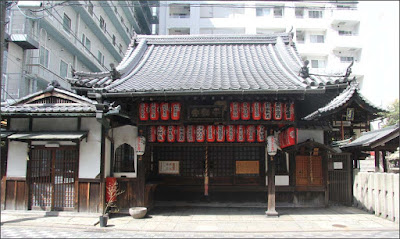:::::::::::::::::::::::::::::::::::::::::::::::::::::::::::::::::::::::::::::::::::::::::::::::::::::::::::::::::::::::::::
Fudoodoochoo, Fudōdōchō 不動堂町
FudoDo-Cho villages
不動堂村 Fudodo Mura
Some villages and streets are named after a 不動堂 Fudo Hall in the neighbourhood.
Kyoto, Miyagi, Chiba . . .
:::::::::::::::::::::::::::::::::::::::::::::::::::::::::::::::::::::::::::::::::::::::::::::::::::::::::::::::::::::::::::
Kyoto 京都市
Fudoodoochoo, Fudōdōchō 不動堂町
FudoDo-Cho in Shimogyo 下京区
and
Fudoochoo, Fudōchō 不動町 Fudo-Cho
in Nakagyo 中京区
. Kyoto- hana no miyako 花の都 .
- Introduction -
In Kyoto there are four towns that were newly established during the change of town names in 1966 in the area west of Kyoto Station
(Kita Fudodo-cho, Minami Fudodo-cho, Higashi Aburanokoji-cho, and Nishi Aburanokoji-cho).
(北・南不動堂町、東・西油小路町)

..............................................................................................................................................
明王院不動堂 Fudo-Do Myo-O-In / Meio-In
京都市下京区油小路塩小路下る南不動堂町7
Aburanokoji, Minami-Fudodo-Cho
Fudondoo Myoo-Oo In 不動堂明王院(ふどんどうみょうおういん)
Fudondo Myo-O In
京都府京都市下京区油小路塩小路下る南不動堂町7
- Kyoto Fudo-Do Machi
fudondoo ふどんどう is the local dialect for the Fudo Hall,
(Fudo No Do . . . fudondo) 不動堂 Fudo Do.

The Fudo Hall is in the compound of an Inari shrine 稲荷社.
It was founded on behalf of Emperor Uda Tenno.


稲荷社(いなりしゃ)Inari-Sha
不動堂(ふどうどう)稲荷社の南にあり Fudo-Do hall is South of the Inari Shrine.
- source : miyakomeisyo -
The main statue is
reiseki Fudo 霊石不動 spirit stone Fudo
The statue is burried deep in the ground and only a "maedachi" copy is to be seen.
In 823 Kobo Daishi Kukai built the temple Tooji 東寺 To-Ji and this Fudo Hall is in the un-auspicious North-Eastern direction of the Kimon 鬼門.
Kukai found a stone tablet in the ground and engraved Fudo Myo-O onto it. The tablet was then saved in a stone casket and sunk deep into the well to protect it from the eyes of normal people.
The temple has been protected by 宇多天皇 Uda Tenno (867 - 931).
In 899 He ordered the well to be shut for the public and gave it the name. Special rituals are performed at this well and the temple.
During the uproars in the Muromachi Period (Onin no ran 応仁の乱 1467) the temple building was lost to fire, but the stone Fudo in the well remained.
The present-day hall was built in 1764.
Emperor Uda 宇多天皇 Uda-tennō
(May 5, 867 – July 19, 931)
was the 59th emperor of Japan, according to the traditional order of succession.
Uda's reign spanned the years from 887 through 897.
- - - More in the WIKIPEDIA !
..............................................................................................................................................
Dooso Jinja 道祖神社 Doso Jinja
"Shrine for the Wayside Deities" (Dosojin, Dososhin)

都市下京区油小路通塩小路下る南不動堂町
Aburanokoji, Shiokoji-sagaru, Minami Fudodo-Cho
- quote -
The deity of matchmaking and marital harmony
Doso-shin (Traveler's Guardian Deity)
is usually placed between streets and villages, hence this deity’s function is protection during travel and helping to avoid evil spirits.
Doso Jinja Shrine was rebuilt during the era of Toyotomi Hideyoshi (late 16th century), but originally it has a quite a long history. Here enshrines Sarutahiko no Mikoto, deity for travel and Ama no Uzume no Mikoto, deity for entertainment.
They’re a married couple deities, therefore, they have been worshiped for successful matchmaking and marital harmony. “Two figures Doso-shin”, there are many Doso-shin statues, but here is a couple statue of a man and a woman snuggled against each other, who are wearing the clothes of Heian period in front of the gate.

It is a small shrine located between the buildings near Kyoto Station. Here you can see a harmonious couple and it makes people smile when they see it.
The benefit of this shrine is for matchmaking, but if you visit with your partner, you can receive a blessing for a long and happy marriage life.
- source : eng.trip.kyoto.jp -
. 道祖神 Dosojin - Introduction .
. 道祖神 Legends about Wayside Gods .
:::::::::::::::::::::::::::::::::::::::::::::::::::::::::::::::::::::::::::::::::::::::::::::::::::::::::::::::::::::::::::
不動堂村屯所跡 Fudodo-Mura Tonsho
remains of military headquarters
in rememberance of the Shinsen-Gumi 新選組
Yagi House (former Shinsengumi Tonsho)

京都市下京区松明町 / Taimatsucho Shimogyo Ward, Kyoto
- source : bakutora.japanserve.com -
. Shinsengumi 新選組 - Introduction .
..............................................................................................................................................

Fudocho Nakagyo Ward, Kyoto
Fudoochoo 不動町 Fudo-Cho 中京

a machiya town house in the Fudocho district.
- reference -
:::::::::::::::::::::::::::::::::::::::::::::::::::::::::::::::::::::::::::::::::::::::::::::::::::::::::::::::::::::::::::
Fudoodoochoo, Fudōdōchō 不動堂町 宮城県 FudoDo-Cho in Miyagi Prefecture

Toda District 遠田郡
It used to be Fudo-Do village 不動堂村 since 1889.
Founded in 1954, former 遠田郡中西部 Central-West Toda District
現在の美里町の小牛田駅周辺にあたる。 Now part of Misato Machi, 小牛田町 Gogota Cho.
遠田郡:涌谷町、北浦村、南郷村 志田郡:松山町、敷玉村

Fudodo Village is Nr. 11. - 11.不動堂村
The village office is in
宮城県遠田郡不動堂町
- - - More in the WIKIPEDIA !
:::::::::::::::::::::::::::::::::::::::::::::::::::::::::::::::::::::::::::::::::::::::::::::::::::::::::::::::::::::::::::
Fudoodoochoo, Fudōdōchō 不動堂町 千葉県 FudoDo-Cho in Chiba Prefecture
- quote -
The 8th general of the Edo bakufu (Japanese feudal government headed by a shogun) Yoshimune TOKUGAWA had already ordered Aoki Konyo to cultivate the known sweet potato as an emergency crop at the famine in West Japan, and make trial pieces in the Koishikawa Medicine Garden (Koishikawa Botanical Gardens), Makuwari-mura village in Chiba District of Shimousa Province (present Makuhari, Hanamigawa-ku Ward, Chiba City, Chiba Prefecture), and
Fudodo Village in Yamabe County of Kazusa Province (present Kujukuri-cho, Sanbu-gun, Chiba Prefecture).
上総国山辺郡不動堂村(現在の千葉県山武郡九十九里町)
- source : ejje.weblio.jp -
青木昆陽 不動堂甘薯試作地
Aoki Konyo Fudodo Kansho Shisakuchi
Memorial stone at the place where he planted the first sweet potatoes.

source : www.pref.chiba.lg.jp/kyouiku
Aoki Konyoo 青木昆陽 (1698 - 1769)
. "Doctor Sweet Potato", 'Master Sweet Potato' - Introduction .
:::::::::::::::::::::::::::::::::::::::::::::::::::::::::::::::::::::::::::::::::::::::::::::::::::::::::::::::::::::::::::

. - Join Fudo Myo-O on facebook - Fudō Myō-ō .
:::::::::::::::::::::::::::::::::::::::::::::::::::::::::::::::::::::::::::::::::::::::::::::::::::::::::::::::::::::::::::
. Pilgrimages to Fudo Temples 不動明王巡礼
Fudo Myo-O Junrei - Fudo Pilgrims .
[ . BACK to WORLDKIGO . TOP . ]
[ . BACK to DARUMA MUSEUM TOP . ]
- - #fudodocho #fudokyoto #fudocho #fudondo - -
:::::::::::::::::::::::::::::::::::::::::::::::::::::::::::::::::::::::::::::::::::::::::::::::::::::::::::::::::::::::::::































